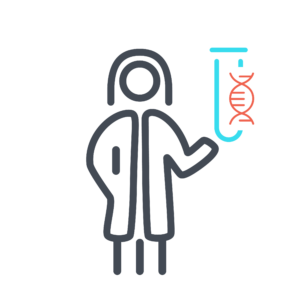KMT2E-Related Syndrome

Table of contents
- What is KMT2E-related syndrome?
- Key Role
- Symptoms
- What causes KMT2E-related syndrome?
- Why does my child have a change in the KMT2E gene?
- What are the chances that other family members of future children will have KMT2E-related syndrome?
- How many people have KMT2E-related syndrome?
- Do people who have KMT2E-related syndrome look different?
- How is KMT2E-related syndrome treated?
- Behavior and development concerns linked to KMT2E-related syndrome
- Medical and physical concerns linked to KMT2E-related syndrome
- Where can I find support and resources?
- Sources and References
KMT2E-related syndrome is also called KMT2E-related neurodevelopmental disorder. For this webpage, we will be using the name KMT2E-related syndrome to encompass the wide range of variants observed in the people identified.
What is KMT2E-related syndrome?
KMT2E-related syndrome happens when there are changes in the KMT2E gene. These changes can keep the gene from working as it should.

Key Role
The KMT2E gene plays a key role in the development of the brain, heart, and eyes.
Symptoms
Because the KMT2E gene is important for brain activity, many people who have KMT2E-related syndrome have:
- Developmental delay, or intellectual disability, or both
- Autism spectrum disorder or features of autism
- Low muscle tone, also called hypotonia
- Seizures
- Speech delay
- Large head size, also called macrocephaly
- Small head size, also called microcephaly
- Sleep issues
- Behavioral issues, including self-injury behaviors, anxiety, aggression, and sensory issues
- Gastrointestinal issues
- Brain changes seen on magnetic resonance imaging (MRI)
What causes KMT2E-related syndrome?
KMT2E-related syndrome is a genetic condition, which means that it is caused by variants in genes. Our genes contain the instructions, or code, that tell our cells how to grow, develop, and work. Every child gets two copies of the KMT2E gene: one copy from their mother’s egg, and one copy from their father’s sperm. In most cases, parents pass on exact copies of the gene to their child. But the process of creating the egg or sperm is not perfect. A change in the genetic code can lead to physical issues, developmental issues, or both.
Sometimes a spontaneous variant happens in the sperm, egg or after fertilization. When a brand new genetic variant happens in the genetic code is called a ‘de novo’ genetic variant. The child is usually the first in the family to have the genetic variant.
De novo variants can take place in any gene. We all have some de novo variants, most of which don’t affect our health. But because KMT2E plays a key role in development, de novo variants in this gene can have a meaningful effect.
Research shows that KMT2E-related syndrome is often the result of a de novo variant in KMT2E. Many parents who have had their genes tested do not have the KMT2E genetic variant found in their child who has the syndrome. In some cases, KMT2E-related syndrome happens because the genetic variant was passed down from a parent.
Autosomal dominant conditions
KMT2E-related syndrome is an autosomal dominant genetic condition. This means that when a person has the one damaging variant in KMT2E they will likely have symptoms of KMT2E-related syndrome. For someone with an autosomal dominant genetic syndrome, every time they have a child there is a 50 percent chance they pass on the same genetic variant and a 50 percent chance they do not pass on the same genetic variant.
Autosomal Dominant Genetic Syndrome
Why does my child have a change in the KMT2E gene?
No parent causes their child’s KMT2E-related syndrome. We know this because no parent has any control over the gene changes that they do or do not pass on to their children. Please keep in mind that nothing a parent does before or during the pregnancy causes this to happen. The gene change takes place on its own and cannot be predicted or stopped.
What are the chances that other family members of future children will have KMT2E-related syndrome?
Each family is different. A geneticist or genetic counselor can give you advice on the chance that this will happen again in your family.
The risk of having another child who has KMT2E-related syndrome depends on the genes of both biological parents.
- If neither biological parent has the same genetic variant found in their child, the chance of having another child who has the syndrome is on average 1 percent. This 1 percent chance is higher than the chance of the general population. The increase in risk is due to the very unlikely chance that more of the mother’s egg cells or the father’s sperm cells carry the same genetic variant.
- If one biological parent has the same genetic variant found in their child, the chance of having another child who has the syndrome is 50 percent.
For a symptom-free brother or sister of someone who has KMT2E-related syndrome, the sibling’s risk of having a child who has KMT2E-related syndrome depends on the sibling’s genes and their parents’ genes.
- If neither parent has the same genetic variant causing KMT2E-related syndrome, the symptom-free sibling has a nearly 0 percent chance of having a child who would inherit KMT2E-related syndrome.

How many people have KMT2E-related syndrome?
As of 2025, more than 120 people with KMT2E-related syndrome have been identified in medical research.

Do people who have KMT2E-related syndrome look different?
People who have KMT2E-related syndrome may look different. Features are usually subtle and nonspecific and no recognizable pattern has been found. Facial features can include some or all of the following:
- Elongated head shape, also called dolichocephaly
- Long forehead
- Deep-set eyes
- Swelling in the tissue surrounding the eyes, also called periorbital fullness
- Noticeable cheekbones, also called malar prominence
- Noticeable folds from the nose to the mouth, also called prominent nasolabial folds

How is KMT2E-related syndrome treated?
Scientists and doctors have only just begun to study KMT2E-related syndrome. At this point, there are no medicines designed to treat the syndrome. A genetic diagnosis can help people decide on the best way to track the condition and manage therapies. Doctors can refer people to specialists for:
- Physical exams and brain studies
- Genetics consults
- Development and behavior studies
- Other issues, as needed
A developmental pediatrician, neurologist, or psychologist can follow progress over time and can help:
- Suggest the right therapies. This can include physical, occupational, speech, or behavioral therapy.
- Guide individualized education plans (IEPs).
Specialists advise that therapies for KMT2E-related syndrome should begin as early as possible, ideally before a child begins school.
If seizures happen, consult a neurologist. There are many types of seizures, and not all types are easy to spot. To learn more, you can refer to resources such as the Epilepsy Foundation’s website: www.epilepsy.com/learn/types-seizures.

This section includes a summary of information from published articles. It highlights how many people have different symptoms. To learn more about the article, see the Sources and References section of this guide.
Behavior and development concerns linked to KMT2E-related syndrome
Researchers have found different pathogenic variants in the KMT2E gene. Most were protein-truncating variants (where the protein is shorter in length than normal, which prevents it from working properly).
A smaller group of about five people had missense variants (where one building block of the protein is swapped for another). These people had more severe symptoms.
Learning
Most people with KMT2E-related syndrome had global developmental delay and/or mild to moderate intellectual disabilities.
- 56 out of 58 people had global developmental delay (97 percent)
- 31 out of 37 people had intellectual disability (84 percent)
Behavior
People with KMT2E-related syndrome had behavioral issues, such as autism spectrum disorder, and sleep issues like frequent waking and/or difficulty falling asleep. Some people had skin-picking behavior, anxiety, aggression, self-injury behavior, and sensory issues.
- 18 out of 47 people had autism spectrum disorder (38 percent)
- 8 out of 17 people had sleep issues (47 percent)
Brain
People with KMT2E-related syndrome had low muscle tone (hypotonia), brain changes seen on magnetic resonance imaging (MRI), seizures, and a larger then average head size (macrocephaly). People with pathogenic missense variants had a smaller than average head size (microcephaly) and more severe seizures than those with pathogenic protein-truncating variants. See points and graph below.
- 23 out of 50 people had hypotonia (46 percent)
- 27 out of 43 people had brain changes seen on MRI (63 percent)
- 16 out of 56 people had seizures (29 percent)
- 29 out of 52 people had macrocephaly (56 percent)
- 3 out of 5 people had microcephaly in people with pathogenic missense variants (60 percent)

Graphs
Percent of neurological features in people with KMT2E-related syndrome
100%
80%
60%
40%
20%
0
Microcephaly for some people with missense variants
Medical and physical concerns linked to KMT2E-related syndrome
Gastrointestinal
Almost one-half of people with KMT2E-related syndrome had gastrointestinal issues like constipation, reflux, vomiting and/or reduced bowel motility.
- 20 out of 45 people had gastrointestinal issues (44 percent)

Where can I find support and resources?
Simons Searchlight
Simons Searchlight is an online international research program, building an ever growing natural history database, biorepository, and resource network of over 175 rare genetic neurodevelopmental disorders. By joining their community and sharing your experiences, you contribute to a growing database used by scientists worldwide to advance the understanding of your genetic condition. Through online surveys and optional blood sample collection, they gather valuable information to improve lives and drive scientific progress. Families like yours are the key to making meaningful progress. To register for Simons Searchlight, go to the Simons Searchlight website at www.simonssearchlight.org and click “Join Us.”
- Learn more about Simons Searchlight: www.simonssearchlight.org/frequently-asked-questions
- Simons Searchlight webpage with more information on KMT2E: www.simonssearchlight.org/research/what-we-study/KMT2E
- Simons Searchlight KMT2E Facebook community: https://www.facebook.com/groups/kmt2e

Sources and References
The content in this guide comes from a published study about KMT2C-related syndrome.
- Pais, L., Rodan, L., & O’Donnell-Luria, A. KMT2E-related neurodevelopmental disorder. 2024 Apr 18. In: Adam MP, Feldman J, Mirzaa GM, et al., editors. GeneReviews® [Internet]. Seattle (WA): University of Washington, Seattle; 1993-2025. Available from: https://www.ncbi.nlm.nih.gov/books/NBK602945/
